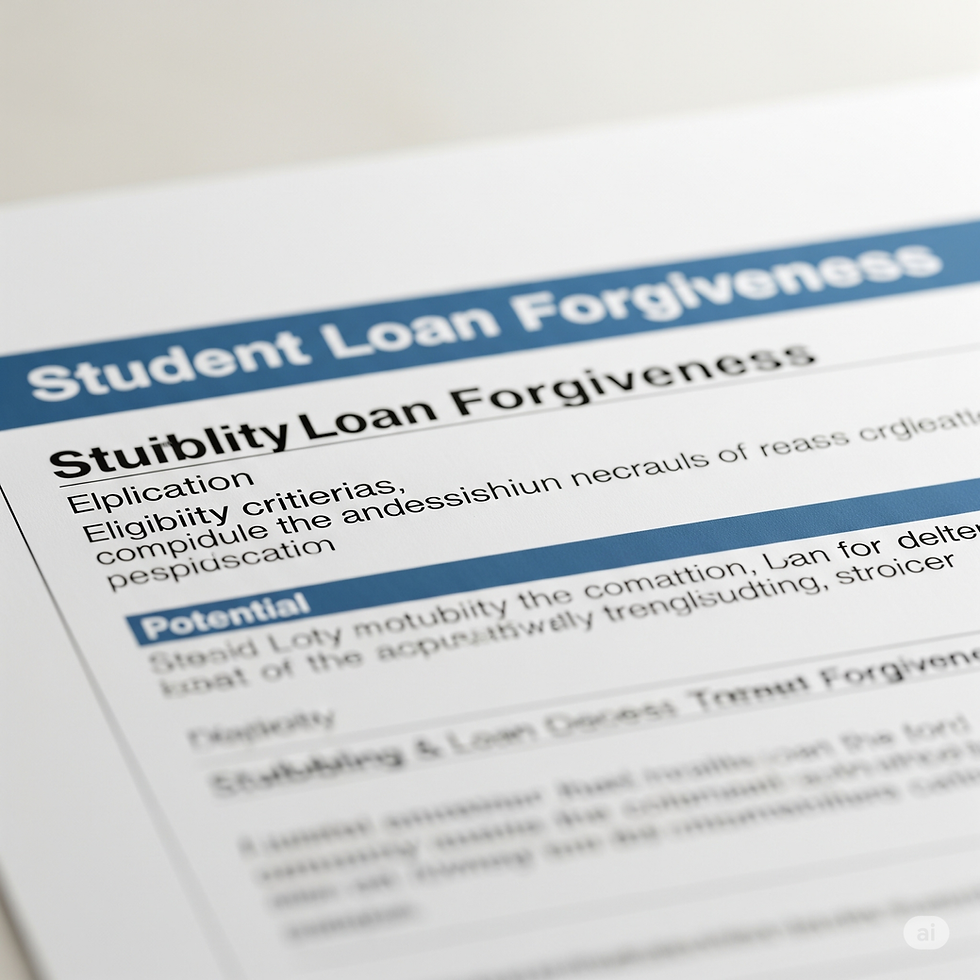Student Loan Forgiveness (IBR): Everything You Need to Know
- Test Mail
- 5 days ago
- 3 min read
If you're struggling with student loan debt, you're not alone. Millions of Americans rely on Income-Based Repayment (IBR) plans to make their loans more manageable—and some even qualify for student loan forgiveness. But how does IBR forgiveness work? Who qualifies? And what steps do you need to take?
This guide breaks down everything you need to know about IBR loan forgiveness, so you can make informed decisions about your student debt.
What Is Income-Based Repayment (IBR)?
Income-Based Repayment (IBR) is a federal student loan repayment plan that caps your monthly payments at a percentage of your discretionary income. Unlike standard repayment plans, IBR adjusts based on your earnings, making it easier to afford payments if you have a low income.

Key Features of IBR:
Monthly payments are 10% or 15% of your discretionary income (depending on when you borrowed).
After 20 or 25 years of qualifying payments, the remaining balance may be forgiven.
Only applies to federal student loans (not private loans).
How Does IBR Loan Forgiveness Work?
The main goal of IBR forgiveness is to help borrowers who’ve been repaying loans for decades but still owe a significant amount. Here’s how it works:
Enroll in an IBR Plan – You must apply and be approved for an Income-Based Repayment plan.
Make Qualifying Payments – You must make 120-300 on-time payments (10-25 years, depending on the plan).
Apply for Forgiveness – After meeting the payment requirement, you can apply to have the remaining balance forgiven.
Important Note: Forgiven amounts under IBR may be taxed as income unless you qualify for Public Service Loan Forgiveness (PSLF).
Who Qualifies for IBR Forgiveness?
Not everyone with student loans is eligible for IBR forgiveness. Here are the key requirements:
· Loan Type: Only federal student loans (Direct Loans, FFEL Loans, etc.) qualify. Private loans do not.
· Repayment Plan: You must be enrolled in an IBR, PAYE, REPAYE, or ICR plan.
· Payment History: You must make 20-25 years of qualifying payments (depending on the plan).
· Income Level: Your payments must be based on a partial financial hardship (for older IBR plans).
Types of IBR Forgiveness Programs
There are multiple student loan forgiveness programs tied to income-driven repayment plans:
1. Standard IBR Forgiveness
Forgives remaining debt after 20-25 years of payments.
Taxable forgiveness (you may owe taxes on the forgiven amount).
2. Public Service Loan Forgiveness (PSLF)
Forgives loans after 10 years (120 payments) for government/nonprofit workers.
Tax-free forgiveness (unlike standard IBR).
3. Teacher Loan Forgiveness
Up to $17,500 forgiven for teachers in low-income schools.
Works alongside IBR but has different rules.
Pros and Cons of IBR Forgiveness
Pros:
· Lower monthly payments based on income.
· Potential for full forgiveness after 20-25 years.
· Flexibility if your income changes.
Cons:
· Long repayment period before forgiveness.
· Tax bomb (forgiven amount may be taxed).
· Not all loans qualify (private loans excluded).
How to Apply for IBR Forgiveness
If you believe you qualify, follow these steps:
Check Your Loan Status – Ensure you have federal student loans in good standing.
Enroll in an IBR Plan – Apply via the Federal Student Aid website.
Make Qualifying Payments – Track your payments carefully.
Submit Forgiveness Application – After meeting requirements, apply for IBR forgiveness.
Frequently Asked Questions (FAQs)
1. Is IBR Forgiveness Taxable?
Yes, unless you qualify for PSLF, the IRS may tax the forgiven amount as income.
2. Can Private Loans Be Forgiven Under IBR?
No, only federal student loans qualify.
3. What Happens If I Miss a Payment?
Missed payments don’t count toward forgiveness. Stay consistent!
4. Can I Switch to IBR If I’m on Another Plan?
Yes, you can switch to IBR at any time if you qualify.
Final Thoughts: Is IBR Forgiveness Worth It?
IBR forgiveness can be a lifeline for borrowers with high debt and low income. However, the 20-25 year timeline and potential tax bomb mean it’s not the best choice for everyone.
If you work in public service, PSLF might be a better option. Otherwise, IBR provides a realistic path to student loan freedom—if you’re patient.
Next Steps
Check your eligibility for IBR forgiveness.
Apply for an income-driven plan if you qualify.
Stay informed about changes to student loan policies.
By understanding Income-Based Repayment (IBR), you can take control of your student loan debt and move closer to financial freedom.



Comentarios